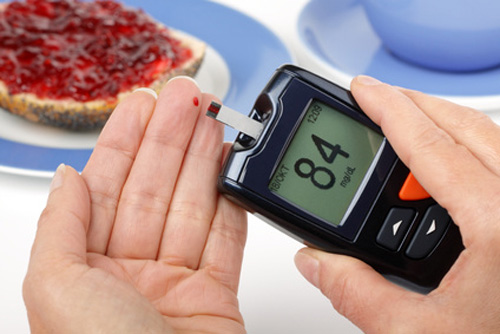Salk scientists have identified a molecule that is produced in fat tissue and which, like insulin, potently and rapidly regulates blood glucose. The finding, they suggest, could potentially lead to the development of new therapies for treating diabetes, as well as representing a foundation for promising new avenues in metabolism research.
The newly reported in vitro and in vivo research demonstrated that the hormone, fibroblast growth factor 1 (FGF1), regulates blood glucose by inhibiting fat breakdown, or lipolysis. And the results suggest that while FGF1 and insulin control blood glucose by inhibiting lipolysis, the two hormones do so in different ways. Importantly, the researchers suggested, this difference could enable FGF1 to be used to lower blood glucose safely and successfully in people who suffer from insulin resistance.
“Finding a second hormone that suppresses lipolysis and lowers glucose is a scientific breakthrough,” said Ronald Evans, PhD, holder of the March of Dimes chair in molecular and developmental biology. “We have identified a new player in regulating fat lipolysis that will help us understand how energy stores are managed in the body.” Evans is co-senior author of the team’s published paper in Cell Metabolism, which is titled, “FGF1 and insulin control lipolysis by convergent pathways.”
The discovery of insulin 100 years ago opened a door that would lead to life and hope for millions of people with diabetes. Ever since then, insulin, produced in the pancreas, has been considered the primary means of treating conditions, such as diabetes, that are characterized by high blood sugar levels.
When we eat, energy-rich fats and glucose enter the bloodstream. Insulin normally shuttles these nutrients to cells in muscles and fat tissue, where they are either used immediately or stored for later use. In people with insulin resistance, glucose is not efficiently removed from the blood, and higher lipolysis increases the fatty acid levels.
These extra fatty acids accelerate glucose production from the liver (hepatic glucose production; HGP), compounding the already high glucose levels. Moreover, fatty acids accumulate in organs, exacerbating insulin resistance—characteristic of diabetes and obesity. “Chronic hyperglycemia and dyslipidemia are hallmarks of type 2 diabetes mellitus (T2DM), attributed to the failure of insulin to appropriately suppress hepatic glucose production and adipose lipolysis,” the authors wrote. “Moreover, unregulated lipolysis leads to the aberrant accumulation of free fatty acids (FFAs) in peripheral metabolic tissues including liver, muscle, and pancreatic islets, further exacerbating disease severity.”
FGF1 has an established role in adaptive adipose remodeling, the team noted. “Mice lacking FGF1 develop a more aggressive diabetic phenotype in response to a dietary challenge (high-fat diet, HFD) that is, in part, attributed to a failure to appropriately remodel adipose tissue.” Previous studies by the Evans lab had also shown that injections of FGF1 dramatically lowered blood glucose in mice and that chronic FGF1 treatment relieved insulin resistance. However, the way that this worked remained a mystery.
For their newly reported studies, the team investigated the mechanisms behind these phenomena and how they were linked. First, they showed that FGF1 suppresses lipolysis, as does insulin. Then they showed that FGF1 regulates the production of glucose in the liver, again, as does insulin. These similarities led the group to wonder if FGF1 and insulin use the same signaling pathways to regulate blood glucose.
It was already known that insulin suppresses lipolysis through PDE3B, an enzyme that initiates a signaling pathway, so the team tested a full array of similar enzymes, with PDE3B at the top of their list. They were surprised to find that FGF1 uses a different pathway—PDE4. “On a molecular level, FGF1 inhibits the cAMP-protein kinase A axis by activating phosphodiesterase 4D (PDE4D), which separates it mechanistically from the inhibitory actions of insulin on PDE3B,” they wrote. Their studies in mice confirmed that overexpression of PDE4D in the adipose tissues of diabetic mice corrected hyperglycemia.
“This mechanism is basically a second loop, with all the advantages of a parallel pathway,” said Evans lab co-author Gencer Sancar, PhD. “In insulin resistance, insulin signaling is impaired. However, with a different signaling cascade, if one is not working, the other can. That way you still have the control of lipolysis and blood glucose regulation.”
Finding the PDE4 pathway opens new opportunities for drug discovery and basic research focused on high blood glucose (hyperglycemia) and insulin resistance. The scientists are looking to investigate the possibility of modifying FGF1 to improve PDE4 activity. Another route is targeting multiple points in the signaling pathway before PDE4 is activated.
“The unique ability of FGF1 to induce sustained glucose lowering in insulin-resistant diabetic mice is a promising therapeutic route for diabetic patients,” said says co-senior author Michael Downes, PhD, a senior staff scientist in the Evans lab. “We hope that understanding this pathway will lead to better treatments for diabetic patients. Now that we’ve got a new pathway, we can figure out its role in energy homeostasis in the body and how to manipulate it.”
The authors concluded, “These findings establish the FGF1/PDE4 pathway as an alternate regulator of the adipose-HGP axis and identify FGF1 as an unrecognized regulator of fatty acid homeostasis … Thus, in addition to a new signaling cascade that suppresses lipolysis, these findings reveal the therapeutic potential of the FGF1-PDE4D axis in diabetes.”






